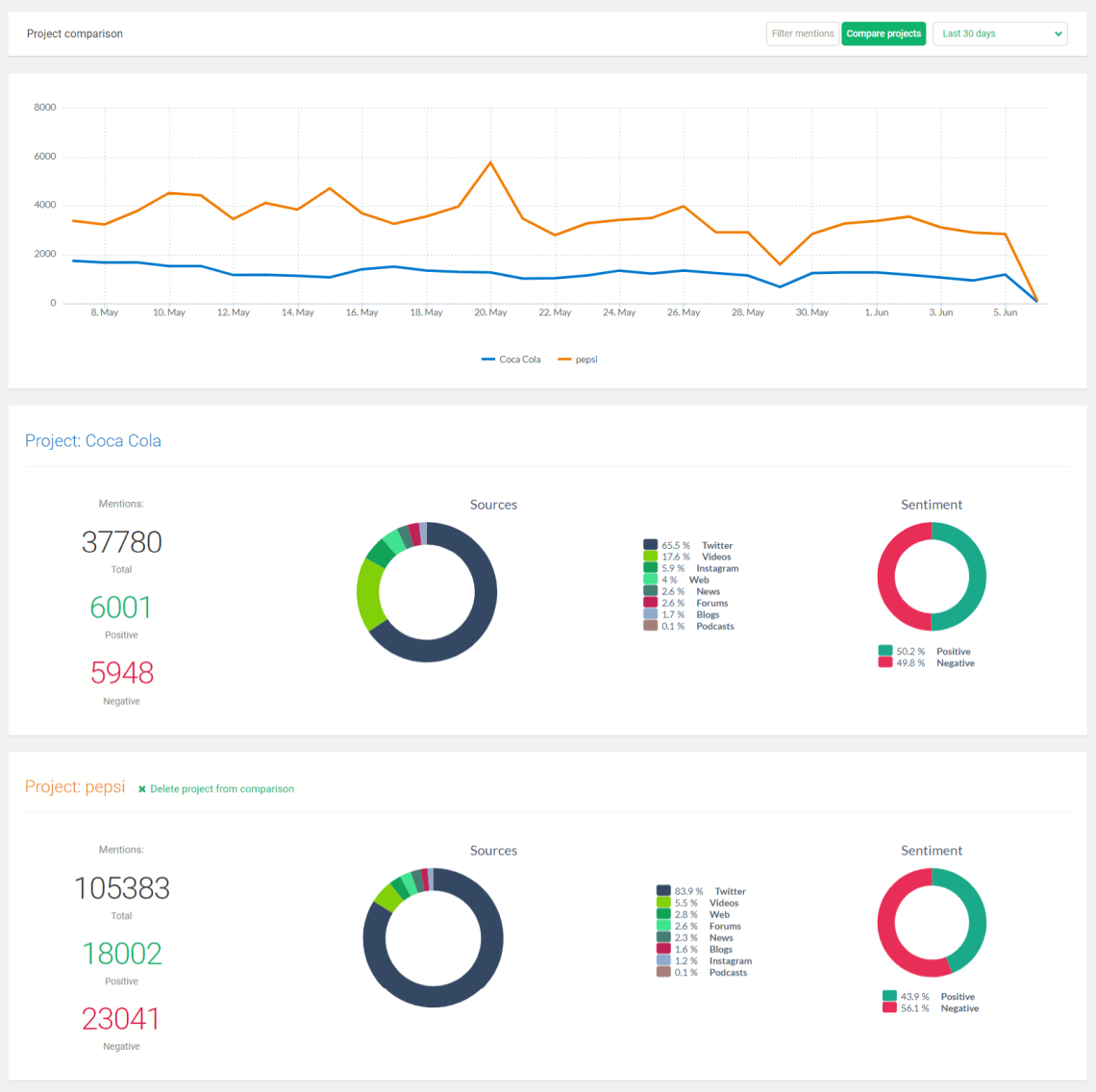Context Analysis: Everything You Need to Know [2022 Guide]
Before you can analyse anything, you need to know the context. That’s just a fact. Contextual data helps informed analysts make better decisions by providing the necessary background information and understanding of underlying trends.
A wrong decision can mean the difference between success and failure, and good data is essential to making the right choice, which is why it’s such an important aspect. Whether it’s a newly-proposed product, a marketing campaign, a social media strategic plan, or anything else, understanding the context is always the first step to the ultimate goal.
But what exactly is context analysis? And how can it help your business? Keep reading to find out everything you need to know about context analysis from a business perspective.
Table of contents:
- What is context analysis and why is it important?
- What is the context of a discussion?
- How to conduct context analysis? 5 steps
- Market advantage context analysis can provide
- Wrap-up
What is context analysis and why is it important?
Context is everything. It’s the who, what, where, when, and why of a situation or event. And it’s important because it helps us make sense of things. Contextual analysis is the process of breaking down a complex issue or problem in order to better understand it.
By looking at the different elements that make up a situation, we can start to see how they all fit together. This can be helpful when trying to find solutions to problems because it allows us to identify potential areas of concern.
Conducting context analysis can also help us build a more complete picture of a situation and see it from multiple perspectives. This can be especially useful in situations where there is conflict or misunderstanding.
When used correctly, context analysis can be an incredibly powerful tool for uncovering the hidden layers of meaning in any given situation.
Context analysis is an important tool for businesses of all sizes. It allows organisations to understand the external factors that may impact their operations and performance.
By analysing the political, economic, social, and technological trends in their industry, businesses can gain a better understanding of the opportunities and threats they face. This information can then be used to develop strategies for growth and success. While context analysis can be complex, it is a valuable tool for any business that wants to stay ahead of the competition.
What is the context of a discussion?
In order to understand the context of a discussion, it is important to consider the circumstances surrounding the conversation.
- Who are the participants?
- What is their relationship to one another?
- What is the purpose of the discussion?
- Is it to reach a consensus, share information, or debate an issue?
An understanding of the context can help to provide clues about what topics are likely to be discussed and how the conversation will proceed. In addition, the context can also shed light on underlying tensions or areas of agreement between the participants. By considering the context, we can begin to get a better understanding of a discussion and where it is coming from.
As a business owner, you’re always looking for ways to get an edge on the competition. One way to do that is to understand how context can affect a discussion. In a business setting, it can include everything from the company’s history and culture to the current economic climate.
By understanding the context of a discussion, you can hone in on the most important issues and make sure your voice is heard.
To do this, you need to be aware of the words that are being used in relation to your monitored phrase. This will give you a better understanding of the conversation and allow you to adjust your approach accordingly.
With this knowledge, you’ll be able to participate in discussions in a way that is both effective and persuasive.
And Brand24 can help you with just that.
That’s because we implemented a new feature recently. Now the Brand24 tool presents additional information concerning the Context of a discussion.
As we wrote in the LinkedIn post, “Now it is possible to discover the sentiment of the most popular words that appear with a monitored phrase.“
How does it work? The tool detects a list of the most popular words that appear with the monitored keyword. The colors of words suggest whether the sentiment is positive (green), neutral (grey), or negative (red).

This gives a whole new level of insight into how your audience feels about a topic, all served on a silver platter.
Brand24 is a tool that detects the context of a discussion.
How to conduct context analysis? 5 steps
Context analysis can be conducted at different levels, from a broad overview of the external environment to a more detailed examination of the specific context within which a project will be implemented. The process typically involves six steps: topic, stakeholder, trend, competition, market, and internal analysis.
Here’s how to do it in more detail.
01 Define the topic
The first step in conducting context analysis is to clearly define the topic. This may seem like a simple task, but it is actually essential to getting accurate and useful information. The reason for this is that the context of a situation can vary widely depending on how it is defined.
For example, when considering the context of a particular business, one might chose to focus on the industry, the company’s competitive landscape, or even the macroeconomic environment.
Each of these perspectives would provide a different lens through which to view the business and its opportunities and challenges. As such, it is important to take care in defining the topic of inquiry before beginning any context analysis.
02 Establish key stakeholders
Stakeholders are individuals or groups who have a vested interest in the outcome of the project. They may be affected by the project, or have the ability to influence its success or failure: customers, employees, investors, and suppliers.
Proper engagement with stakeholders is critical to ensuring that the project meets their needs and expectations. And for proper engagement, you need to be on top of things with tools like social listening.
The first step is to identify who the key stakeholders are. This can be done by conducting a stakeholder analysis, which will help to identify those who have the most power and influence, as well as those who are most likely to be affected by the project.
Once the key stakeholders have been identified, it is important to engage them in the planning process. This includes soliciting their feedback on the objectives and scope of the project, and involving them in decision-making. By engaging stakeholders early on, businesses can ensure that their projects are successful and meet everyone’s needs.
03 Trend analysis
Trends can usually be analysed using the PEST analysis.
It’s a framework that business analysts use to scan the external macro-environmental factors in which an organisation operates. PEST stands for Political, Economic, Social, and Technological.
Many businesses use PEST analysis as part of their environmental scanning or strategic planning process. By understanding the potential impact of these four external forces, organisations can make more informed decisions about their strategic direction.
- Political events include government regulation, tax policy, or trade restrictions.
- Economic factors include inflation, interest rates, or economic growth.
- Social factors include demographics, consumer trends, or social attitudes.
- Technological factors include Research & Development spending, technology infrastructure, or patent activity.
In order to conduct a PEST analysis, businesses first need to identify which political, economic, social, and technological trends are most relevant to their particular market. They then need to assess the potential impact of these trends on their business. This assessment can be quantitative or qualitative in nature.
Looking into the industry-related discussion is what you want to do.
Once the assessment is complete, businesses can develop strategies to mitigate the risks posed by these trends or capitalise on any opportunities they present.
Brand24 is a tool that detects the context of a discussion.
04 Competitor analysis
Context analysis involves taking a close look at your competitors and understanding their strengths and weaknesses. This information can then be used to develop a strategy that will help you gain an edge over your rivals.
To conduct context analysis, start by searching for your competitors online. Look at their website, social media pages, and any other online presence they may have. Pay attention to their marketing messages and the overall tone of their communications.
Media monitoring of branded competition keywords can be helpful here! Furthermore, it will help you to conduct competitor analysis and comparison.

Also, take a look at their customer base and consumer demand. Try to identify their target audience and understand what needs or wants they are trying to address. Determine their low price strategy, defensive and offensive actions, as well as competitive forces.
05 Investigate your internal environment
When you’re investigating your internal environment as part of a competence analysis, SWOT is a helpful tool, one of many such analysis techniques. SWOT stands for strengths, weaknesses, opportunities, and threats. By looking at these four factors, you can get a well-rounded view of your company’s current situation.
To begin a SWOT analysis, start by brainstorming a list of your company’s strengths. These could include things like a strong reputation, experienced staff, financial stability, or innovative products or services.
Once you’ve identified your strengths, move on to brainstorming a list of weaknesses. These might include things like high overhead costs, inflexible processes, lack of market share, or dependence human factors.
After you’ve identified your company’s strengths and weaknesses, it’s time to turn your attention to external factors that could either be opportunities or threats.
Opportunities might include things like demographic trends in your favor, developing trends in your industry, or loosening regulations.
On the other hand, threats could include things like a recession, a new competitor entering your market, or changing consumer tastes.
Market advantage context analysis can provide
Now that you know a little bit more about context analysis, you might be wondering what the main benefits of this business tool are. Here are some of the top reasons to conduct context analysis on a regular basis:
Better understanding of your industry
By taking the time to do a context analysis, you will be able to identify opportunities and threats, and develop strategies for taking advantage of both.
More information about your general competition
By taking the time to understand the larger context within which your business operates, you can gain valuable insights into your competitors’ strategies and how best to respond to them. Context analysis can help you to identify opportunities and threats, and it can also provide a framework for developing your own competitive advantage.
The ability to identify new opportunities
Context analysis can be a helpful tool for finding new opportunities. This involves studying the external factors that can affect your business, such as changes in the economy or new technologies. By understanding the context in which your business operates, you can be better prepared to identify new opportunities when they arise.
Additionally, context analysis can help you to understand the potential risks and challenges associated with new opportunities, so that you can make informed decisions about whether or not to pursue them.
A deeper understanding of consumer needs
Businesses today face immense pressure to show they understand their customer’s needs and wants. Contextual analysis provides powerful consumer insights that help to reveal what they really care about.
It goes beyond providing simply a description of customer behaviour – it delves into the emotions, motivations and circumstances that shape those behaviours. With this deeper understanding, businesses can adapt their offerings to be more relevant and appealing to their target markets, even ahead of time.
Improved communication with customers
Context analysis is critical for businesses that want to improve communication with customers and become more efficient and effective in their marketing efforts. With such an analysis, businesses can tailor their messaging to meet customer needs and better align their marketing efforts with customer behaviour.
Targeting the right audience
When you are trying to reach a specific audience, it’s important to make sure that your message is on target. With contextual information in hand, you can then craft a message that resonates with them.
Set up the Brand24 tool to detect the context of a discussion.
Wrap-up
Businesses that take the time to do a context analysis can reap many benefits. This involves studying the external factors that can affect your business, such as changes in the economy or new technologies. By understanding the context in which your business operates, you can be better prepared to identify new opportunities when they arise.
Want to discover the most popular words your customers use online? Try Brand24 and conduct the context of a discussion!



